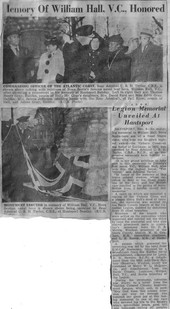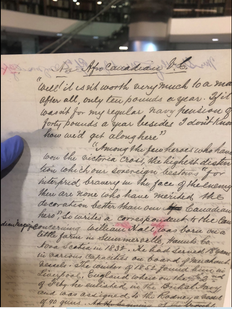Hall, William
- BCV.stories

- Dec 23, 2021
- 4 min read
Updated: Feb 17, 2022

The Victoria Cross was and remains the highest award for valour in the face of the enemy that can be awarded in the Commonwealth. William Hall was the third Canadian and the first Black man in the British Empire to receive the award. His actions during the Sepoy Rebellion in India in 1857 are examples of bravery.
William Nelson Hall was born in Nova Scotia on 27 April 1827. His parents had escaped slavery in the United States near the end of the War of 1812. He worked in the shipyards at nearby Hantsport. In 1844 Mr. Hall took to the sea to pursue a living. He served in merchant ships sailing in the Bay of Fundy. For two years he served in the United States Navy (1847-1849). He then went back to the merchant navy.
On 2 February 1854 Mr. Hall enlisted in the Royal Navy in Liverpool. His first major ship was the 90- gun HMS Rodney. The ship sailed for the Mediterranean Sea and then served two years in the area during the Crimean War. Able Seaman Hall participated in the battles of Inkerman and Sevastapol. He was part of HMS Rodney's naval brigade that provide gunfire in support of the army.
Hall was an excellent sailor. When he joined HMS Shannon in 1859 he was appointed captain of the foretop, a very important position. This meant he was responsible for the men who would furl and unfurl the sails of the forward mast, as well as for the rigging of the mast. In May 1857 the Sepoy Rebellion broke out in India. HMS Shannon sailed to help suppress the rebellion.
At Lucknow, a group of about 1800 soldiers and 800 women and children were under siege from about 10,000 Sepoys. HMS Shannon provided a force of 410 sailors and marine to provide gunfire to the army. Hall was one of the sailors. The Shannon Brigade, as it was known, began to march overland to Lucknow bringing eight guns with them. They were under constant harassment from the Sepoy. In one instance Hall rushed to a gun where the crew had been cut down, three other sailors followed. They were able to drive the Sepoys away.
Arriving at Lucknow, the Shannon Brigade provided support to the British Army. On 16 November 1857 the guns tried to break down the stone walls of the Shah Nujeef mosque, being used as a stronghold. But they were too far away to have any effect. The 93rd Highland Regiment tried to storm the walls but were cut down by the Sepoys. Two guns were moved to within 20 metres of the walls; Hall volunteered to go with them. The cannonballs from the guns began to break down the wall, but the Sepoy gunfire killed or injured all of the men manning the guns until only Hall and Lieutenant Thomas Young were left standing. Their effort created a small break that allowed the 93rd Highlanders to take the mosque and end the siege. The Shannon Brigade remained there until March 1858.
For their bravery Hall and Lieutenant Young were recommended for the Victoria Cross. This was approved on 1 February 1859. On 28 October 1859 Hall received the Victoria Cross. Rear Admiral Charles Talbot made the presentation on HMS Donegal, anchored in Queenstown Harbour, Ireland.
In 1860 Hall was selected to be a member of the crew of HMS Hero, the ship selected to bring His Royal Highness, Prince Edward (later King Edward VII) to North America for the first ever royal tour of North America. The crew were hand picked sailors, all of whom had been decorated for valour. One of the stops was in Halifax, but it was likely too brief for Hall to visit his family.
Later in his service Petty Officer Hall was likely involved in training new naval recruits. He served on the HMS Impregnable which was a training ship by then. He also served on the new ironclad ship HMS Bellerophon, a steam powered vessel.
Petty Officer Hall retired 10 July 1876 after almost 23 years service. He retired to a small farm outside Avonport, overlooking the Minas Basin. His sisters Rachel Robinson and Mary Hall looked after the aging veteran. In 1901, the future King George V, while visiting Halifax, saw Hall. The prince recognized the medals, and spoke with Petty Officer Hall.
Petty Officer Hall died on 25 August 1904 and was buried in a small plot at Lockhart. Besides the Victoria Cross, he received the Indian Mutiny Medal for the Sepoy Rebellion, the British Crimea Medal and the Turkish Crimea Medal. Hall remained mostly forgotten. But in 1945 he was re-interred in a place of honour at Hantsport, commemorated with a marker befitting a war hero.
Petty Officer Hall's medals remained outside Canada until 1967. Rear-Admiral H.L. Pullen worked to repatriate his medals. They are now on display in the Nova Scotia Museum in Halifax. Petty Officer Hall was featured on Canada Post stamp for Black History Month in 2010. he was also designated a National Historic Person by the Canadian Historic Sites and Monuments Board at October that year and a new plaque was unveiled at his monument. The fourth of the new Arctic Offshore Patrol vessels will be named in his honour.
HMCS Hall -Keel laying for HMCS Hall

.png)




















Comments